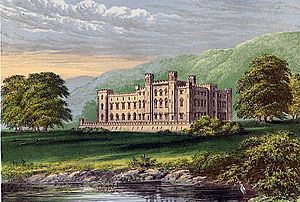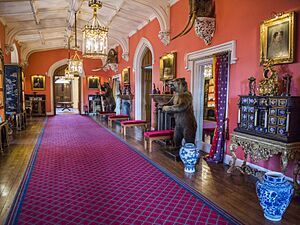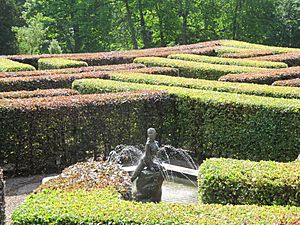Scone Palace facts for kids
Quick facts for kids Scone Palace |
|
|---|---|
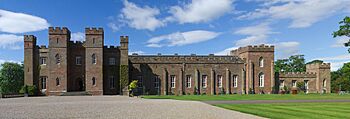
Scone Palace, front façade
|
|
| Location | Perth, Perth and Kinross, Scotland, United Kingdom |
| Built | 12th century |
| Rebuilt | 1802–1807 |
| Architect | William Atkinson |
| Architectural style(s) | Gothic Revival style |
| Lua error in Module:Location_map at line 420: attempt to index field 'wikibase' (a nil value). | |
Scone Palace is a very old and important house near the village of Scone and the city of Perth, Scotland. It's the family home of the Earls of Mansfield. This beautiful building is made of red sandstone and has a special castle-like roof. It's a great example of the Gothic Revival style in Scotland.
Scone was once the site of an early Christian church. Later, it became an Augustinian priory, which is a type of monastery. For hundreds of years, Scone Abbey, located on the palace grounds, held the famous Stone of Scone. This stone was used to crown the early Kings of Scotland. Robert the Bruce was crowned here in 1306. The last king crowned at Scone was Charles II in 1651.
Scone Abbey was badly damaged in 1559 during the Scottish Reformation. This happened after a crowd, inspired by the reformer John Knox, came from Dundee. Even after this event, the Abbey became a family home in 1600. The Palace has been the home of the Earls of Mansfield for over 400 years. In the early 1800s, the palace was made much bigger by architect William Atkinson. He updated the old palace while keeping its medieval look.
Today, the Palace and its large grounds are open to visitors. You can explore its beautiful gardens, which include a collection of fir trees and a fun star-shaped maze.
Contents
History of Scone Palace
Scone has a very long and interesting history. For many centuries, it was a central place for Scottish kings and important events.
Ancient Beginnings and the Name Scone
Scotland started keeping written records later than some other kingdoms. The first clear record about Scone is a document from the year 906. This shows how old and important the area is.
The exact reason why the area is called "Scone" is not fully known. Over the last 1,000 years, the name has been spelled in many different ways. Scone was at the heart of the ancient Pictish kingdom. So, its name might come from the old Pictish language. Some believe "Scone" comes from a word meaning "cut" or "cutting." This could relate to a place called "the Friars' Den."
The Stone of Destiny and Royal Coronations
Scone was the special crowning place for the Kings of Scots from at least the 9th century. It was also home to the famous Stone of Scone, also known as the Stone of Destiny. Many important kings were crowned here. These include Kenneth MacAlpin, who was traditionally the first King of Scots, Macbeth (from Shakespeare's play), Robert the Bruce, and Charles II. In total, 42 Scottish kings were crowned at Scone. People believed that no king could truly rule Scotland unless they were crowned at Scone on the Stone of Scone.
In 1296, Edward I of England took the Stone of Scone to Westminster Abbey. The special Coronation Chair there was made to fit over it. Today, the Stone of Scone is kept at Edinburgh Castle, along with the Scottish crown jewels.
Scone Abbey and Early Parliaments
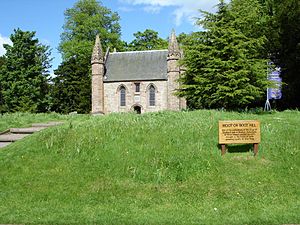
Scone was an ancient meeting place for the Picts. It was likely the site of an early Christian church. The place where kings were crowned was called Caislean Credi, which means 'Hill of Credulity'. This is now known as the Moot Hill. In the Middle Ages, a stone cross marked this mound. However, it disappeared during the Scottish Reformation in 1559, when the Abbey buildings were attacked by a crowd from Dundee.
From 1114 to 1559, Scone was one of Scotland's most important monasteries, and later an abbey. The Abbey church was built in the Romanesque style, with a tall central tower. Between 1284 and 1402, Scone Abbey often hosted the Parliament of Scotland. This shows how important Scone was for the country's government.
King Constantine II held an important meeting at Scone in 906. This meeting was recorded in the Chronicle of the Kings of Alba, which was an early name for the Kingdom of Scotland. The record says that the King and a Bishop met at the Hill of Belief near Scone. They promised to follow the laws of faith and the laws of the church.
Scone was a center of power in the ancient Kingdom of Alba. It was where kings were crowned and where parliaments met. It was also a royal home and hunting ground. King Robert II likely spent much of his life at Scone. He was buried in the Abbey, but his grave has never been found.
An old saying shows how important Scone was: "As the Bell of Scone rang, So mote it be." This means that when decisions were made at Scone, they became the law of the land. Another old saying in Gaelic is: "Counsel of the bell of Scone, Touch not what is not thine own." These sayings show Scone's key role in Scottish history.
The Moot Hill at Scone is also called 'Boot Hill'. This name might come from an old tradition. Nobles would swear loyalty to their king while wearing soil from their own lands in their boots. This meant the Moot Hill grew from soil brought from all over Scotland. When kings were crowned on this hill, they were making a promise to all the people of Scotland. They were symbolically standing on all of Scotland as they made their vows.
The Modern Scone Palace
The palace you see today was designed by William Atkinson. It was built in the Gothic Revival style for the 3rd Earl of Mansfield. It was finished in 1807. One of its most famous parts is the long gallery. The 3rd Earl was very happy with the new house, calling it a "handsome and agreeable residence."
More work was done on the palace in 1842 to prepare for a visit from Queen Victoria and Prince Albert.
Inside the Palace
When you visit Scone Palace, you can see many amazing collections in its State Rooms. These include beautiful furniture, delicate ceramics, carved ivories, and old clocks. Some special items are chairs by Pierre Bara, pieces by Robert Adam and Chippendale, and fine Dresden and Sèvres porcelains. There are also Vernee Martin vases and a writing desk given to the 2nd Earl of Mansfield by Marie-Antoinette.
The palace also has many Scottish and British portraits. These include works by famous artists like Reynolds and Ramsay. One well-known painting is "The Village Politicians" by Sir David Wilkie.
The Lennox Room is named after the Duke of Lennox. It has many items with royal connections. This includes a bed-hanging that was made by Mary Queen of Scots.
The collection of large European ivories came from places like Bavaria, Italy, and France. They were carved in the 1600s, 1700s, and 1800s from elephant and walrus tusks. The 4th Earl of Mansfield collected most of them.

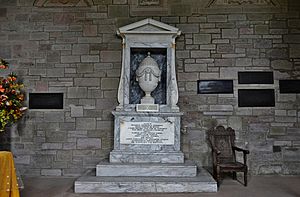
On the Moot Hill, you can see a copy of the Stone of Scone. In front of it is a 17th-century chapel. Inside this chapel is a beautiful monument to the 1st Lord Scone. The chapel also has a monument to the first wife of the 2nd Earl of Mansfield.
Gardens and Grounds
The Murray Star shaped maze is a fun feature in the grounds. It covers a large area and is planted with a mix of copper and green beech trees. The design looks like the Earl of Mansfield's family tartan, which is a type of Scottish plaid. The maze is shaped like a five-pointed star, which is part of the Mansfield family symbol.

The grounds of Scone Palace also have beautiful woodlands. Some of the fir trees are over 250 years old. Scone Palace was the first place in Britain where the Douglas fir tree species was introduced by David Douglas.
Notable Gardeners
- David Douglas (botanist)
- David Taylor Fish
See also
 In Spanish: Palacio de Scone para niños
In Spanish: Palacio de Scone para niños


